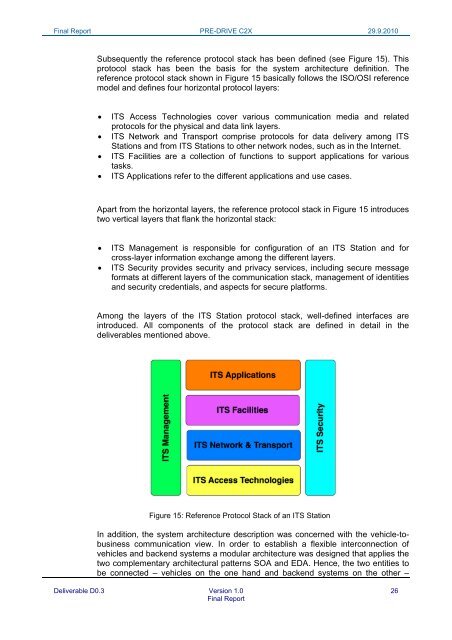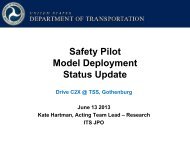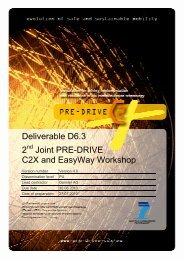PRE-DRIVE C2X Deliverable D0.3 Final report_20100929.pdf
PRE-DRIVE C2X Deliverable D0.3 Final report_20100929.pdf
PRE-DRIVE C2X Deliverable D0.3 Final report_20100929.pdf
You also want an ePaper? Increase the reach of your titles
YUMPU automatically turns print PDFs into web optimized ePapers that Google loves.
<strong>Final</strong> Report <strong>PRE</strong>-<strong>DRIVE</strong> <strong>C2X</strong> 29.9.2010<br />
Subsequently the reference protocol stack has been defined (see Figure 15). This<br />
protocol stack has been the basis for the system architecture definition. The<br />
reference protocol stack shown in Figure 15 basically follows the ISO/OSI reference<br />
model and defines four horizontal protocol layers:<br />
ITS Access Technologies cover various communication media and related<br />
protocols for the physical and data link layers.<br />
ITS Network and Transport comprise protocols for data delivery among ITS<br />
Stations and from ITS Stations to other network nodes, such as in the Internet.<br />
ITS Facilities are a collection of functions to support applications for various<br />
tasks.<br />
ITS Applications refer to the different applications and use cases.<br />
Apart from the horizontal layers, the reference protocol stack in Figure 15 introduces<br />
two vertical layers that flank the horizontal stack:<br />
ITS Management is responsible for configuration of an ITS Station and for<br />
cross-layer information exchange among the different layers.<br />
ITS Security provides security and privacy services, including secure message<br />
formats at different layers of the communication stack, management of identities<br />
and security credentials, and aspects for secure platforms.<br />
Among the layers of the ITS Station protocol stack, well-defined interfaces are<br />
introduced. All components of the protocol stack are defined in detail in the<br />
deliverables mentioned above.<br />
Figure 15: Reference Protocol Stack of an ITS Station<br />
In addition, the system architecture description was concerned with the vehicle-tobusiness<br />
communication view. In order to establish a flexible interconnection of<br />
vehicles and backend systems a modular architecture was designed that applies the<br />
two complementary architectural patterns SOA and EDA. Hence, the two entities to<br />
be connected – vehicles on the one hand and backend systems on the other –<br />
<strong>Deliverable</strong> <strong>D0.3</strong> Version 1.0 26<br />
<strong>Final</strong> Report







